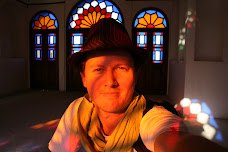Photos are here: http://picasaweb.google.com/nickchasingthesunrise/Syria
My assumptions about Syria were mostly political – branded as a “rogue state”; technically still at war with Israel; and its ruling military-political dynasty are Baathists like Iraq. But I had heard much of the legendary kindness of the Syrians, the magnificence of Palmyra and some great food.
My shared taxi started to put some serious kilometres between us and the border with Jordan. The landscape reflected the change and I felt like I was entering an entirely different civilisation and something about the olive groves and faces strangely made me think I was closer to Europe. I felt watched wherever I went, the ubiquitous serene face of President Assad (and his father), gazing at me from posters, billboards, car tintings, t-shirts, bumper stickers and more.
The taxi dropped me around 9pm at a bus station on the edge of Damascus, perched high above the city. I flagged a local taxi which wove its way to the city centre and dropped me near the Saahat Yousef Al-Azmeh intersection in the Saroujah district. Totally lost but somewhere near the backpacker area, I soon enlisted the help of a Palestinian and Syrian who outdid each other to help and show me the way. I strolled into the Al-Rabie Hotel and immediately felt relaxed - it is a large old house with a courtyard cooled by extensive vines and an open roof, surrounded by rooms and populated by an eclectic bunch of traveller types. I was soon set up in the dorm with its high ceilings and ancient furniture.
I was ravenous so explored the lanes around the Al-Rabie where I found a late night eatery with humous, fuul (beans) and bread with tasty mint tea. Then found the Star Crossed Lovers café and its family of waiters who helped to make the café my 2nd home in Damascus. I met a few Syrian students there plus Amak (Mohammad), an Indonesian studying Arabic, who was so shocked to hear Indonesian (especially from a bule) that he asked his Syrian friend in English, “What did he say?” :) We talked politics and religion until late which was to become a much anticipated end to every day.
The next morning I sprang out of my single, narrow bed and headed straight for the old city, past the citadel into the fabled Hamidiyya Souq (bazaar). Hamidiyya really impresses the first time you see its huge domed main avenue lined with shops stretching deep into the old city, fed by small and tiny lanes. It took me 45 minutes to reach the end of the souq, surfing my way through veiled mothers and their children, stylish and sexy young women and men checking out the latest fashions and each other, businessmen in tight fitted suits on a mission and shop owners pleading their cases. I fuelled up for the day on a huge, fresh sandwich made with flat, warm bread wrapping hot felafel with tomato, cucumber, lettuce, fine lemon slices and topped with lashings of tahina (sesame seed sauce) and liberally sprinkled with fresh mint leaves. I munched it with a fresh raspberry juice at the Western Temple Gate gazing at the walls and minarets of the impressive Ummayad Mosque. Highlights of the old city include:
Ummayad Mosque: had to don a fetching green skirt as my shorts (laundry day) were not appropriate and swished my way through the huge wooden doors into the expansive courtyard with its fountains, pool and marble floor striped in black and white in the Syrian style. Converted in the 10th century from a Byzantine cathedral which itself was built on the site of a Temple of Jupiter built in 705AD, the mosque has amazing mosaics and stained glass decorating its rooms and corridors. Next door is the Mausoleum of Saladin, the heroic Islamic vanquisher of the Crusaders.
Sayyida Ruqayya: dazzling Persian built mosque dedicated to the daughter of Husein, son of the original Caliph Ali (Mohammad’s cousin) with mirror work interior and brilliant blue and turquoise exterior.
Azem Palace: built in 1749 by the Governor of Damascus, with lovely striped stonework and well restored rooms and displays for dining, sleeping, greeting, working and playing.
Old city streets and cafes: magical lanes and alleys going in all directions stocked with shops offering everything you could ever need, including clothing, material, perfumes, food, brasswork, spices and jewellery, covered with trellises stocked with lush vines and awnings provided much needed respite from the 45 degree heat. At the end of most days I flopped into the old An-Nafura café near the eastern gate and people watched with nargileh (water pipe) in one hand and mint tea in the other.
Subscribe to:
Post Comments (Atom)

No comments:
Post a Comment
Note: only a member of this blog may post a comment.